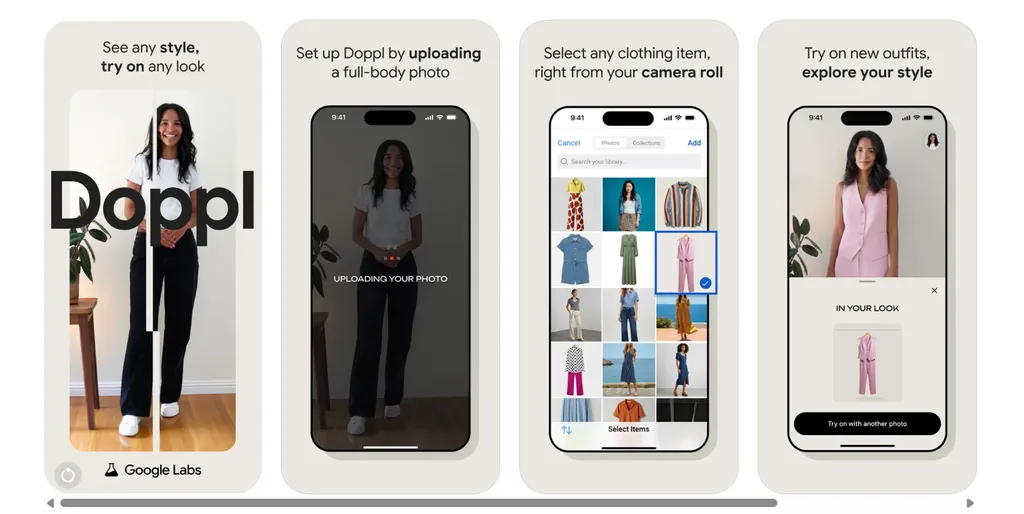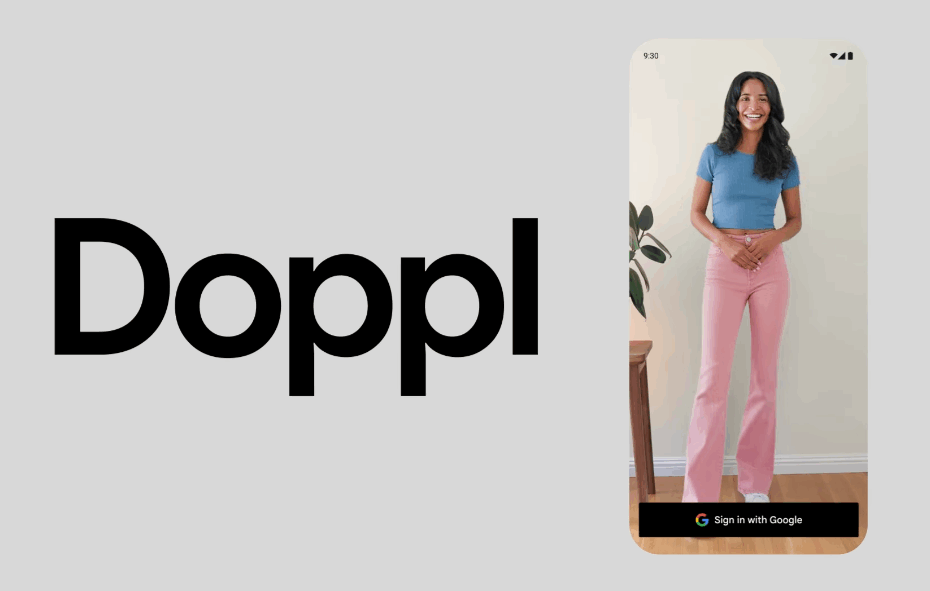It’s a familiar modern ritual: hours spent scrolling through online stores, finding what seems to be the perfect outfit, and clicking “buy,” only to be met with disappointment when the package arrives. The fit is wrong, the color is off, the fabric doesn’t hang right. The physical fitting room, for all its flaws, has remained a crucial, irreplaceable step in the shopping journey—until now.
In June 2025, Google quietly released Doppl, an experimental app from its Google Labs division that aims to solve this very problem. At its core, Doppl is a virtual try-on (VTO) tool, but one with a significant twist. It empowers users to see how any outfit, from any source, might look on their own body.
By uploading a full-body photo of themselves and a screenshot of a piece of clothing—whether from a high-fashion website, a friend’s social media post, or a snapshot of a thrift store find—users can generate a digital image of themselves wearing the item.
But Doppl’s most talked-about feature is its ability to bring these static images to life. With the tap of a button, the app generates a short, animated video of the user’s digital avatar moving, walking, or turning, offering a dynamic sense of how the fabric might drape and flow. This is more than just a digital dress-up doll; it’s a sophisticated glimpse into a future where the lines between online inspiration and real-world style are irrevocably blurred.
However, to view Doppl as merely a consumer-facing shopping aid is to miss the forest for the trees. Launched as a standalone experiment, separate from the main Google Shopping ecosystem, the app is a strategic play. It functions as a massive, real-world data-gathering operation, designed to train and refine Google’s powerful AI models on the infinite complexities of fashion and human form.
Doppl isn’t just changing how we see clothes; it’s a key part of Google’s ambitious plan to fundamentally reshape the architecture of online commerce.
Also Read: YouTube introduces AI search but creators aren’t celebrating
A New Kind of Mirror: The Doppl Experience

Using Doppl is designed to be a simple, almost playful process. After downloading the free app—currently available only to users in the United States aged 18 and over—you are prompted to create a personalized model. This can be done by uploading a clear, full-body photograph or, for those wary of sharing personal images, by selecting from a range of pre-made AI models.
From there, the fashion world is your oyster. Any image of clothing from your phone’s camera roll can become your next virtual outfit. The app’s AI then gets to work, generating a new image of your avatar in the selected attire. The “animate” button is where the magic happens, converting the still picture into a moving video that provides a more realistic preview of an outfit’s style.
These creations can be saved within the app or shared with friends for a second opinion, a feature that cleverly mimics real-world shopping habits while simultaneously turning users into organic promoters of the technology.
Initial hands-on reviews praised the app’s potential, with many testers describing the results as “surprisingly realistic” and a clear improvement over guessing how an item might look. The animation, in particular, was lauded as a key differentiator. However, the app’s experimental nature was also apparent, with users reporting frequent glitches, lag, and error messages.
Also Read: DeepSeek R2 launch uncertain amid NVIDIA chip shortage
More telling was the feedback from the user community, which quickly identified the app’s core limitation. As one Reddit user noted after trying the app, “it 100% just assumes a good fit.” Another clarified that the app is for “aesthetic questions, not fit ones.” Users with non-standard body proportions found that Doppl generated flawlessly fitting results for clothes they knew would not fit in reality.
Google itself acknowledges this, stating that “fit, appearance, and clothing details may not always be accurate.” This positions Doppl not as a tool for solving the primary cause of online returns—incorrect sizing—but as a powerful engine for style exploration.
Beyond the App: Decoding Google’s Grand Strategy
The decision to launch Doppl under the Google Labs banner is a calculated one. This incubator for experimental AI products allows Google to test advanced technology in public, gathering invaluable user feedback without the pressure of immediate commercial success or flawless performance.
Technologically savvy users quickly deduced the app’s true purpose. “They are just training AI so they can later sell it to companies,” one commenter astutely observed. Another added, “They are probably also collecting a 3D model of yourself as well.” This is the fundamental value exchange of Doppl: a free, fun app in return for a massive, diverse dataset of human bodies and clothing preferences—the fuel needed to build a state-of-the-art fashion AI.
This strategy connects directly to the broader vision Google unveiled at its I/O 2025 conference: the rise of “agentic AI.” This refers to autonomous AI systems that can execute complex, multi-step tasks on a user’s behalf. In e-commerce, this translates to an “agentic shopper”—an AI assistant that could take a command like, “Find me a dress for a summer wedding under$200,” and handle the entire process from research to checkout.
The biggest hurdle for such a system is user trust. Few would delegate a purchase to an AI without confidence in its choices. This is where Doppl becomes indispensable. It is the development of the “eyes” for this future shopping agent. The AI could present its findings and then ask, “Would you like to see how it looks on you?”
This visual verification step is crucial to building the trust necessary for autonomous commerce to become mainstream. Doppl, therefore, is not the end product; it is a critical R&D project for a foundational piece of Google’s future.
Also Read: Google’s new AI Search in India now answers your most complex questions
A Crowded Field with a Clear Divide
Google is not the first to enter the VTON space, but its strategy sets it apart. The competitive landscape is dominated by retail giants who use the technology as an integrated sales tool to move their own inventory.
Walmart’s “Be Your Own Model” feature, powered by its acquisition of the VTON company Zeekit, allows users to create a personal avatar to try on over 270,000 items from Walmart’s catalog. The goal is singular: increase conversions and reduce returns for Walmart products.
Amazon employs a multi-pronged approach. Its “See It On Your Model” feature uses generative AI to display clothing on a diverse array of real models, while its AR “Virtual Try-On” works for shoes and makeup. The company is also phasing out its physical “Try Before You Buy” program, pushing users toward these AI tools and signaling a clear strategic shift.
Zalando, a European e-commerce leader, has taken a laser-focused approach, piloting a virtual fitting room specifically for jeans. Users enter their height and weight to create a 3D avatar, and a heatmap shows where the selected jeans would fit tightly or loosely, directly tackling the problem of fit rather than just aesthetics.
These companies use VTON as a feature within their walled gardens. Doppl, in contrast, is a standalone data tool. Its ability to work with any image from any source makes it a universal style explorer. This “try anything” approach poses a long-term disruptive threat.
By creating a universal VTON layer for the internet, Google could level the playing field, allowing a small independent designer to be “tried on” with the same ease as an item from Amazon, fundamentally challenging the competitive moats of the retail giants.
Also Read: Google unveils Gemini CLI, a free AI tool for every developer
The Double-Edged Sword: Ethics, Privacy, and Body Image
The power of Doppl also brings significant ethical questions to the forefront. The most pressing is data privacy. To function, the app requires users to upload a full-body photograph—a highly sensitive piece of biometric data—to Google’s servers. Google’s privacy policy is intentionally broad, stating that data is collected to “provide, improve, and develop Google products and services and machine learning technologies.” While the company says data is disconnected from user accounts before human review, the potential for this data to be used for hyper-personalized advertising in the future remains a significant concern.
The technology also presents a “body image paradox.” On one hand, it can be empowering, allowing users to see clothes on their own unique bodies rather than on idealized models, potentially fostering body positivity and style exploration.
On the other hand, an inaccurate or unflattering AI rendering can be just as damaging to self-esteem as a harsh fitting room mirror. The line between visualization and alteration is thin, with some AI photo apps explicitly offering tools to digitally sculpt one’s physique, reinforcing unrealistic beauty standards.
Furthermore, the potential for misuse is a valid concern. Without robust safeguards, there is little to prevent users from uploading photos of other people without their consent to create “creepy/embarrassing dress up pictures.” All generated images are watermarked with Google’s SynthID to identify them as AI-created, but this may not be enough to deter misuse.
Also Read: Gartner predicts 40% of Agentic AI projects will fail by 2027
The Future of Fashion, Forged in Data
Despite the challenges, the potential benefits of VTON for the fashion industry are immense. The technology promises to address some of the sector’s most persistent problems, including high return rates and the environmental impact of reverse logistics and overproduction.
By helping consumers make better choices, VTON can reduce the massive carbon footprint associated with shipping and processing returns. The data gathered can also help brands forecast demand more accurately, minimizing the waste of unsold inventory.
This is a key component of “Fashion 4.0,” a new, data-driven paradigm for the industry. The data from VTON interactions can be fed back into AI-powered design tools, personalized marketing campaigns, and optimized supply chains, creating a real-time feedback loop between consumer desire and industrial production.
The future of Doppl itself will likely involve international expansion and the addition of currently unsupported categories like shoes and accessories. Ultimately, the standalone app may be absorbed into Google’s core products, like Gemini or AI Mode in Search, as some users have already suggested. The long-term goal is likely not an app, but a platform—a ubiquitous VTON utility offered via an API that could become a foundational layer of the internet’s commercial infrastructure.
While it’s easy to dismiss Doppl in its current, experimental state as a “gimmick,” doing so would be a mistake. It is a tangible glimpse into a future of commerce that is more visual, more personal, and increasingly autonomous.
The app itself may be fleeting, a common fate for projects from Google Labs. But the technology it is pioneering—and the vast, unparalleled dataset it is collecting—will fundamentally alter the fabric of fashion and retail for years to come.





